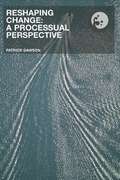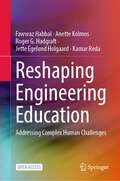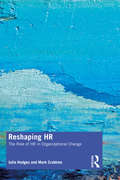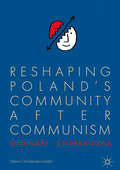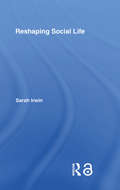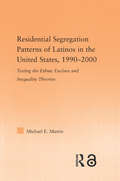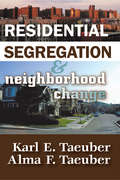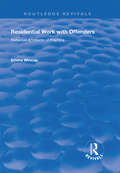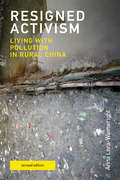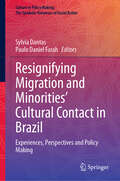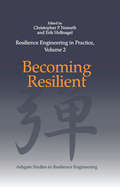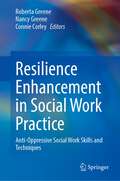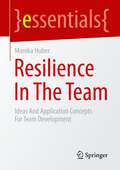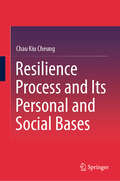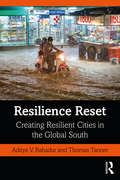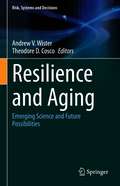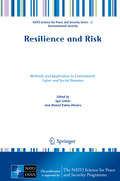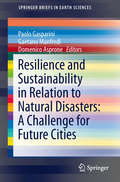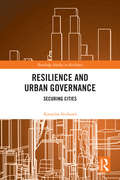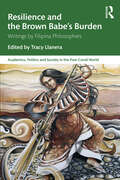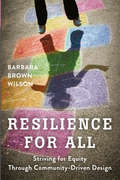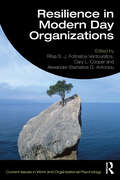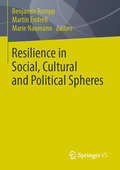- Table View
- List View
Reshaping Change: A Processual Perspective
by Patrick DawsonThis book highlights the theoretical and practical value of using a processual perspective to make sense of organizational change. Featuring data collected over 20 years of fieldwork, it does much more than provide a simple overview of theory and change models and instead makes the processual approach understandable and accessible to both researchers and practitioners.The author's case studies of radical and large-scale change programmes include those from General Motors, Pirelli, Shell, Britax and Laubman and Pank, and considers aspects of processual research, the context, politics, and substance of change and finally the future of the processual perspective. This is an innovative and highly practical study that captures the truly complex processes of the changing organization and illustrates how best to understand them from a processual point of view.
Reshaping Change: A Processual Perspective (Routledge Studies in Organizational Change & Development #Vol. 8)
by Patrick DawsonThis book views change as an ongoing process that should not be solidified or treated as a series of linear events. In drawing on data collected from over 40 years of research, it highlights the theoretical and practical value of using a processual perspective. Illustrative examples from a range of organizations including: Micro-X, General Motors, Pirelli Cables, BHP Billiton, Royal Dutch Shell, British Rail, British Aerospace, Hewlett Packard, Laubman and Pank and the CSIRO make the approach understandable and accessible to both researchers and practitioners. In a theoretical exploration of temporal context, sociomaterial relations and power-political processes the dynamics of changing organizations is brought to the fore and the implication for reshaping change examined. On the practice of engaging in longitudinal research, study design, data collection and processual analysis, as well as the write-up and dissemination of findings, are all considered. This is an innovative and highly practical research monograph that captures the truly complex processes of changing organizations and illustrates how these are best understood from a processual perspective.
Reshaping Engineering Education: Addressing Complex Human Challenges
by Anette Kolmos Fawwaz Habbal Roger G. Hadgraft Jette Egelund Holgaard Kamar RedaThis open access book is dedicated to exploring methods and charting the course for enhancing engineering education in and beyond 2023. It delves into the idea that education, coupled with social connections, is indispensable for a more profound comprehension of the world and the creation of an improved quality of life.The book serves as a conduit for incorporating complex problem-solving into engineering education across various formats. It offers a structured approach for tackling complex issues, comparing an array of techniques for managing complexity within the realm of engineering education. Moreover, the book scrutinizes several complex case studies derived from the United Nation's Sustainable Development Goals. Additionally, it explores intricate problem-solving and curriculum change case studies specific to engineering education from Harvard University, the University of Technology Sydney, and Aalborg University.
Reshaping HR: The Role of HR in Organizational Change
by Julie Hodges Mark CrabtreeThe aim of this book is to explore the contribution HR can make to how organizations enact change within the context of an environment of increasing complexity driven by global forces for change. In particular the book focuses on the role of HR in creating value for organizations and engaging stakeholders during transformations. This aim is achieved in several distinct ways. First, a critical perspective is provided of the role of HR in organizational change by examining evidence-based theories, models and frameworks. Second, the book is grounded in empirical evidence from a study conducted by the authors amongst managers and HR professionals across the globe. This provides unique data on the challenges and opportunities which the practice of HR faces within the context of organizational change. Third, consideration is given as to how HR can play an active and constructive role in co-creating sustainable change with managers, employees and other stakeholders. Fourth, the book identifies the capabilities required by HR professionals in order to engage effectively with organizational change. Finally, aware of the dangers of prescriptive lists, the HR practices offered in this book are provided as a basis for amendment, as necessary, by readers depending upon the context of individual organizations. The book will be of value to practising HR professionals as well as students studying HRM and change and development in organizations. Our proposal in this book is that since people are of significant importance to the success of change, and HR knowledge and expertise is vital to the experience and engagement of individuals and teams, internal and external to the organization, there needs to be clarity about the role of HR in transformations. We suggest that HR’s raison d’être is to focus on the people aspect of organizational change and that this needs to be done within the context of improving organizational effectiveness and wellbeing.
Reshaping Poland’s Community after Communism: Ordinary Celebrations
by Helena Chmielewska-SzlajferHarnessing a cultural sociological approach to explore transformations in key social spheres in post-1989 Poland, Chmielewska-Szlajfer illuminates shifts in religiosity, sympathy towards others, and civic activity in post-Communist Poland in the light of Western influence over elements of Polish life.Reshaping Poland’s Community after Communism focuses on three major cases, largely ignored in Polish scholarship: (1) a hugely popular, faux-baroque Catholic shrine, which illustrates new strategies adopted by the Polish Catholic Church to attract believers; (2) Woodstock Station, a widely known free charity music festival, demonstrating new practices of sympathy towards strangers; and (3) the emergence of national internet pro-voting campaigns and small-town watchdog websites, which uncover changes in practical uses of civic engagement. In exploring grass-roots, everyday negotiations of religiosity, charity, and civic engagement in contemporary Poland, Chmielewska-Szlajfer demonstrates how a country’s cultural changes can suggest wider, dramatic democratic transformation.
Reshaping Rohingya Futures: Coping Strategies and Emerging Agencies
by Nasir UddinThis edited book presents many hitherto unaddressed aspects of post-genocide Rohingya lives in refugee camps in Bangladesh. Amid an everyday struggle for daily essentials, violent tensions within and outside the camps, growing anti-Rohingya sentiment in the host community as well as the decreasing international support during the repatriation process, Rohingya adolescents and youths show strategies of coping and agency to alter their present and reshape their future. An upsurge in digital literacy, mounting transnational connectivity, growing engagement with diaspora Rohingya activism and a cumulative presence in social media for sentiment mobilisation on a local and global scale has motivated them to bring about change for themselves and their community within the camps. This book accommodates such fresh and high-quality research on the Rohingya refugees living in the borderland of Bangladesh and Myanmar, conducted by acclaimed academics, professional researchers, and committed activists from across the world, for researchers and students of migration, sociology of race and ethnicity, anthropology, diaspora studies, peace and conflict studies and social work.
Reshaping Social Life
by Sarah IrwinCaught up in current social changes, we do not fully understand the reshaping of social life. In sociological analyses there is a conceptual gap between subjectivities and social structural processes, and we face real difficulties in understanding social change and diversity. Through analysis of key areas of social life, here, Sarah Irwin develops a new and exciting resource for better understanding our changing social world. Breaking with conventional approaches and reconnecting the subjective with the objective, Irwin’s book develops a new conceptual and analytical perspective with social relationality, interdependence and social context at its heart. The new perspective is developed through grounded analyses of empirical evidence, and draws on new data. It explores and analyzes: * significant changes in family forms, fertility, gender relations and commitments to employment, children and care, both now, and with comparisons to early twentieth century developments * the meshing of norms and social relations in contexts of change* diverse values, norms and perceptions of fairness, analyzed with respect to diversity over the life course, and in respect of gender, ethnicity and social class. Through analysis of context, Irwin offers new insights, and tackles puzzles of explanation. Reshaping Social Life offers a fascinating and innovative way of slicing into and re-interrogating our changing social world, and is sure to become a landmark resource for students, scholars and researchers.
Residential Segregation Patterns of Latinos in the United States, 1990-2000: Testing The Ethnic Enclave And Inequality Theories (Latino Communities: Emerging Voices - Political, Social, Cultural and Legal Issues)
by Michael E MartinHistorically, residential segregation of Latinos has generally been seen as a result of immigration and the process of self-segregation into ethnic enclaves. The only theoretical exception to ethnic enclave Latino segregation has been the structural inequality related to Latinos that have a high degree of African ancestry. This study of the 331 metropolitan area in the United States between 1990 and 2000 shows that Latinos are facing structural inequalities outside of the degree of African ancestry. The results of the author's research suggest that Latino segregation is due to the mobility of Latinos and structural barriers in wealth creation due to limited housing equity and limited occupational mobility. In addition, Latino suburbanization appears to be a segregation force rather than an integration force. This study also shows that Mexicans, Puerto Ricans and Cubans have different experiences with residential segregation. Residential segregation of Cubans does not appear to be a problem in the U.S. Puerto Ricans continue to be the most segregated Latino sub-group and inequality is a large factor in Puerto Rican segregation. A more in-depth analysis reveals that the Puerto Rican experience is bifurcated between the older highly segregated enclaves where inequality is a large problem and new enclaves where inequality and segregation are not an issue. The Mexican residential segregation experience reflects that immigration and mobility are important factors but previous theorists have underestimated the barriers Mexicans face in obtaining generational wealth and moving from the ethnic enclave into the American mainstream.
Residential Segregation and Neighborhood Change
by Karl E. Taeuber Alma F. TaeuberThis book is an invaluable reference. First published in 1965, it is at once a snapshot of a moment in history and a timeless conceptualization of the issues inherent in societal segregation.Residential segregation historically occupies a key position in patterns of race relations in the urban United States. It not only inhibits the development of informal, neighborly relations between white people and African Americans, but ensures the segregation of a variety of public and private facilities. The clientele of schools, hospitals, libraries, parks, and stores is determined in large part by the racial composition of the neighborhood in which they are located. Problems created by residential segregation are the focus of this of this work.African Americans in cities resemble whites in cities. Both racial groups are highly urbanized, and most of the immigrants of either race to a city are former residents of another city. Within cities, racial groups display similar patterns of residential behavior, with those of higher incomes seeking out newer and better housing. Both races respond similarly to national, social, and economic factors which set the context within which local changes occur. Karl E. and Alma F. Taeuber's main approach to the analysis of residential segregation and processes of neighborhood change is comparative and statistical. By quantitative comparison of the situation in many different cities, they attempt to assess those patterns and processes which are common to all communities and those which vary.Residential segregation is shown to be a prominent and enduring feature of American urban society. By bringing empirical data to bear on an important and timely social problem, this book will aid in the search for reasonable solutions. All types of cities, southern and northern, large and small, are beset with the difficulties that residential segregation imposes on harmonious race relations and on the solution of pressing city prob
Residential Work with Offenders: Reflexive Accounts of Practice (Routledge Revivals Ser.)
by Emma WincupThis title was first published in 2002: Throughout the book reflexive accounts of practice gathered from qualitative research in four different types of bail and probation hostels (women-only, women-only with provision for children, mixed and men-only) are used to argue that the combination of working with a difficult client group in a difficult setting creates a unique blend of professional and personal anxieties. These reflexive accounts are located within their broader social and criminal justice context, and analyzed in relation to contemporary criminological and sociological debates. The result is a detailed insight into the everyday world of bail and probation hostels covering issues such as managing risk and violence, coping with stress and evaluating practice.
Resigned Activism, revised edition: Living with Pollution in Rural China (Urban and Industrial Environments)
by Anna Lora-WainwrightAn examination of the daily grind of living with pollution in rural China and of the varying forms of activism that develop in response.Residents of rapidly industrializing rural areas in China live with pollution every day. Villagers drink obviously tainted water and breathe visibly dirty air, afflicted by a variety of ailments—from arthritis to nosebleeds—that they ascribe to the effects of industrial pollution. In Resigned Activism, Anna Lora-Wainwright explores the daily grind of living with pollution in rural China and the varying forms of activism that develop in response. This revised edition offers expanded acknowledgment of the contributions of Lora-Wainwright&’s collaborators in China.Lora-Wainwright finds that claims of health or environmental damage are politically sensitive, and that efforts to seek redress are frustrated by limited access to scientific evidence, growing socioeconomic inequalities, and complex local realities. Villagers, feeling powerless, often come to accept pollution as part of the environment; their activism is tempered by their resignation. Drawing on fieldwork done with teams of collaborators, Lora-Wainwright offers three case studies of &“resigned activism&” in rural China, examining the experiences of villagers who live with the effects of phosphorous mining and fertilizer production, lead and zinc mining, and electronic waste processing. The book also includes extended summaries of the in-depth research carried out by Ajiang Chen and his team in some of China&’s &“cancer villages,&” village-sized clusters of high cancer incidence. These cases make clear the staggering human costs of development and the deeply uneven distribution of costs and benefits that underlie China&’s economic power.
Resignifying Migration and Minorities' Cultural Contact in Brazil: Experiences, Perspectives and Policy Making (Culture in Policy Making: The Symbolic Universes of Social Action)
by Sylvia Dantas Paulo Daniel FarahThis volume provides in-depth discussions on the challenges of intercultural encounters in Brazil. It analyzes existing policies related to migration and minorities and proposes innovative approaches to policy-making. It also highlights policies that have had a real social impact. The volume consolidates theoretical contributions from authors of different but convergent fields to indicate the role of culture and cultural processes in a wide range of phenomena such as psychosocial intervention with immigrants, emigrants, returnees and refugees, homelessness, mental health and interculturality, mobility in urban settings, monolingualism and monocultural curriculum at Brazilian schools and universities, besides narratives of new and older immigrants. Displacement is one of the 21st century's greatest challenges, and this volume provides interdisciplinary perspectives on mobility and people in cultural contact in Brazil, the largest country in South America and the fifth most populous in the world. Although seen from a Brazilian scenario, issues discussed here permeate all other countries that are diverse and receive immigrants, and shed light on the complex socio-cultural world in which we live.
Resilience Engineering in Practice, Volume 2: Becoming Resilient (Ashgate Studies in Resilience Engineering)
by Erik Hollnagel Christopher P. NemethThis is the fifth book published within the Ashgate Studies in Resilience Engineering series. The first volume introduced resilience engineering broadly. The second and third volumes established the research foundation for the real-world applications that then were described in the fourth volume: Resilience Engineering in Practice. The current volume continues this development by focusing on the role of resilience in the development of solutions. Since its inception, the development of resilience engineering as a concept and a field of practice has insisted on expanding the scope from a preoccupation with failure to include also the acceptable everyday functioning of a system or an organisation. The preoccupation with failures and adverse outcomes focuses on situations where something goes wrong and the tries to keep the number of such events and their (adverse) outcomes as low as possible. The aim of resilience engineering and of this volume is to describe how safety can change from being protective to become productive and increase the number of things that go right by improving the resilience of the system.
Resilience Enhancement in Social Work Practice: Anti-Oppressive Social Work Skills and Techniques
by Nancy Greene Roberta Greene Connie CorleyAs people around the globe experience more civil unrest and environmental disruption, the difficulties social workers face in their practice are becoming increasingly complex. This textbook deepens and expands the resilience-enhancing stress model (RESM) skill set and techniques so that social workers can more effectively serve clients and constituencies who are trying to overcome the stress of difficult life transitions and challenging environmental demands. It is designed as a companion piece to A Resilience-Enhancing Stress Model: A Social Work Multisystemic Practice Approach (Springer, 2022). The intent of the RESM is to further expand social workers' practice skill sets with additional concepts from the anti-oppressive practice (AOP) and coaching literature that aligns with the Educational Policy and Accreditation Standards from the Council on Social Work Education (CSWE). The book's 12 chapters are organized around life transitions and illustrate skills, techniques, and interviews important to the enhancement of resilience. Among the topics covered:The Resilience-Enhancing Stress Model: Articulating Anti-Oppressive PracticeExploring the Role of Cultural Diversity in Resilient Social Functioning: Theory and SkillsCountering Human Rights Violations During Life TransitionsFacilitating Community Development Following DisruptionResilience Enhancement in Social Work Practice: Anti-Oppressive Social Work Skills and Techniques uniquely offers practitioners a knowledge base to exponentiate their efficacy in identifying and fortifying resilience in a time in history when it appears to be imperative. It is written for a student social work audience at the generalist or advanced generalist level for practice across a range of populations and settings. It contains traditional and contemporary human behavior content that supports a social work narrative methodology and a life course perspective. It could be taught with its predecessor across one or two semesters. Practitioners in the field who are new to this content could also find the text a valuable resource.
Resilience In The Team: Ideas And Application Concepts For Team Development (essentials)
by Monika HuberThis essential provides insights into approaches, procedures and ideas on how resilience, understood as resistance, can be promoted and implemented in a team. Most of the time, these concepts are only applied to individuals. But many of the findings from resilience research can be transferred to teams and even extended. Today, resilience is also playing an increasingly important role in teams: whether it is to strengthen the sense of coherence according to Antonovsky's principle of salutogenesis, or to consider other resilience factors that support team capability
Resilience Process and Its Personal and Social Bases
by Chau Kiu CheungThis book is to elucidate personal and social bases for personal resilience, thus addressing the issue concerning the predominance of social factors in shaping resilience. Essentially, the book starts with a clarification of resilience as a phenomenon rather than a trait. The clarification also identifies the personal bases in terms of the resilience process, which specifies belief about resilience as a precursor to learning about resilience, action for resilience, and resilience successively. To justify the personal and social bases, the book expounds the analytical-functionalist framework to specify voluntaristic and deterministic mechanisms to perform the four requisite functions of goal attainment, adaptation, integration, and latency. Equipped with the conceptual and theoretical grounds, the book proceeds to scrutinize the effects of personal and social factors on resilience and its process. The personal factors include personal background characteristics, personality, functional disability, and various beliefs, whereas the social factors include experiences of caring, peace, violence, and social exclusion in society, kindness, sociability, and aid from other people, and social capital. The scrutiny engages five databases about 6.948 Chinese people in Hong Kong and neighboring Chinese cities, composed of the public, service users, older adults, students, and people with visual impairment. Overall, the book presents ample theoretical and empirical substances to clarify the genesis of resilience.
Resilience Reset: Creating Resilient Cities in the Global South
by Thomas Tanner Aditya V. BahadurDrawing on evidence from urban resilience initiatives around the globe, the authors make a compelling argument for a "resilience reset", a pause and stocktake that critically examines the concepts, practices and challenges of building resilience, particularly in cities of the Global South. In turn, the book calls for the world’s cities to alter their course and "pivot" towards novel approaches to enhancing resilience. The book presents shifts in ways of acquiring and analysing data, building community resilience, approaching urban planning, engaging with informality, delivering financing, and building the skills of those running cities in a post-COVID world grappling with climate impacts. In Resilience Reset, the authors encourage researchers, policymakers, and practitioners to break out of existing modes of thinking and doing that may no longer be relevant for our rapidly urbanising and dynamic world. The book draws on the latest academic and practice-based evidence to provide actionable insights for cities that will enable them to deal with multiple interacting shocks and stresses. The book will be an indispensable resource to those studying urbanisation, development, climate change and risk management as well as for those designing and deploying operational initiatives to enhance urban resilience in businesses, international organisations, civil society organisations and governments. It is a must-read for anyone interested in managing the risks of climate impacts in urban centres in the Global South.
Resilience and Aging: Emerging Science and Future Possibilities (Risk, Systems and Decisions)
by Andrew V. Wister Theodore D. CoscoOlder aged adults face many adversities over the later life course. This edited volume will address the ways in which seniors bounce back from different types and combinations of adversity – termed “resilience”. While research has been accumulating that identifies inherent abilities and external resources needed to adapt and navigate stress-inducing experiences among aging and older adults, gaps remain in understanding the unique elements and processes of resilience. A series of chapters included in this book will address several overarching questions: why do some older individuals/families/communities adapt to adversity better than others; what are modifiable behavioral protective/risk factors related to resilience; and how can we foster resilience at the individual/community level and which approaches show the most promise?The spectrum of aging-related challenges and responses addressed in this book include: mental health; physical/functional health problems; multimorbidity; socio-economic deprivation; social isolation and loneliness; cultural dimensions of loneliness; housing/homelessness problems; and environmental disasters. This book presents cutting-edge science at the conceptual, methodological, empirical and practice levels applied to emerging resilience sub-fields in gerontology. It will also present potential areas of future research, policy and practice linked to these areas.During a period of the most rapid population aging in the US, Canada and many other nations, coupled with heightened global socio-political change, extending our knowledge of resilience will help society to make important adjustments to maximize health and wellness of older individuals. Supporting and enhancing resilience through technological, social and/or community-level advances in geroscience will help those facing adversity to thrive by harnessing, stretching, and leveraging a wide array of potential resources. The promotion of healthier older populations has far-reaching consequences for health care and social/community support systems, both in terms of public health including pandemic response, and the development and implementation of innovations in treatment and practice guidelines.
Resilience and Risk
by Igor Linkov José Manuel Palma-OliveiraThis volume addresses the challenges associated with methodology and application of risk and resilience science and practice to address emerging threats in environmental, cyber, infrastructure and other domains. The book utilizes the collective expertise of scholars and experts in industry, government and academia in the new and emerging field of resilience in order to provide a more comprehensive and universal understanding of how resilience methodology can be applied in various disciplines and applications. This book advocates for a systems-driven view of resilience in applications ranging from cyber security to ecology to social action, and addresses resilience-based management in infrastructure, cyber, social domains and methodology and tools. Risk and Resilience has been written to open up a transparent dialog on resilience management for scientists and practitioners in all relevant academic disciplines and can be used as supplement in teaching risk assessment and management courses.
Resilience and Sustainability in Relation to Natural Disasters: A Challenge for Future Cities
by Paolo Gasparini Gaetano Manfredi Domenico AsproneThe number of megacities worldwide is rapidly increasing and contemporary cities are also expanding fast. As a result, cities and their inhabitants are becoming increasingly vulnerable to the effects of catastrophic natural events such as extreme weather events (recently more frequent and intense as a result of the ongoing climate changes), earthquakes, tsunamis or man-induced events such as terrorist attacks or accidents. Furthermore, due to increasing technological complexity of urban areas, along with increasing population density, cities are becoming more and more risk attractors. The resilience of cities against catastrophic events is a major challenge of today. It requires city transformation processes to be rethought, to mitigate the effects of extreme events on the vital functions of cities and communities. Redundancy and robustness of the components of the urban fabric are essential to restore the full efficiency of the city's vital functions after an extreme event has taken place. These items were addressed by an interdisciplinary and international selection of scientists during the 6th UN-World Urban Forum that was held in Naples, Italy in September 2012. This volume represents in six chapters the views from sociologists, economists and scientists working on natural risk and physical vulnerability on resilience and sustainability for future cities in relation to natural disasters.
Resilience and Urban Governance: Securing Cities (Routledge Studies in Resilience)
by Katarína SvitkováThis book challenges the concept of ‘urban resilience’ by exploring its impact and limitations in three cities. Resilience has become a buzzword in science, industry and policy, and this volume offers a fresh perspective on urban resilience as a regulatory and constitutive principle of governance in cities. Cities constitute an extremely relevant playground for resilience, as they are exposed to various disruptions from natural disasters and pandemics to political conflicts and terrorism. This book traces the evolution of urban resilience, from international development organizations to local governments and communities. It explores how this concept was adopted and mobilized by different actors for different purposes, and analyses the resulting resilience momentum in Barcelona, San Francisco, and Santiago. The book outlines the extent to which resilience has become a universal policy tool and a desired end-state, despite its clearly problematic definition. It also contributes to the discussion about contemporary governance, safety and security in times when their very nature and feasibility are being questioned. This book will be of much interest to students of resilience studies, urban studies, development studies, human geography, and International Relations.
Resilience and the Brown Babe’s Burden: Writings by Filipina Philosophers (Academics, Politics and Society in the Post-Covid World)
by Tracy LlaneraThis volume examines the concept and practice of resilience from the perspective of Filipina philosophers. It investigates the double-edged nature of resilience and other key assumptions and ideas about human resilience and resilient cultures and institutions. The chapters in the collection are intersectional in approach, drawing from feminist theory, social and political philosophy, critical theory, pragmatism, virtue theory, social epistemology, and decolonial theory in their engagement of the theme. Part of the Academics, Politics and Society in the Post-Covid World series, the book will be of interest to scholars and students of philosophy, political theory, feminist theory, philosophy of education, cultural studies, and development studies. It will be valuable to academics in Philippine Studies, Asian and Southeast Asian Studies, and Global South Studies.
Resilience for All: Striving for Equity Through Community-Driven Design
by Barbara Brown WilsonIn the United States, people of color are disproportionally more likely to live in environments with poor air quality, in closeproximity to toxic waste, and in locations more vulnerable to climate change and extreme weather events.In many vulnerable neighborhoods, structural racism and classism prevent residents from having a seat at the table when decisions are made about their community. In an effort to overcome power imbalances and ensure local knowledgeinforms decision-making, a new approach to community engagement is essential.In Resilience for All, Barbara Brown Wilson looks at less conventional, but often more effective methods to makecommunities more resilient. She takes an in-depth look at what equitable, positive change through community-drivendesign looks like in four communities—East Biloxi, Mississippi; the Lower East Side of Manhattan; the Denbyneighborhood in Detroit, Michigan; and the Cully neighborhood in Portland, Oregon. These vulnerable communities haveprevailed in spite of serious urban stressors such as climate change, gentrification, and disinvestment. Wilson looks at how the lessons in the case studies and other examples might more broadly inform future practice. She shows how community-driven design projects in underserved neighborhoods can not only change the built world, but also provide opportunities for residents to build their own capacities.
Resilience in Modern Day Organizations (Current Issues In Work And Organizational Psychology Ser.)
by Cary L. Cooper Fotinatos-Ventouratos, Ritsa S. J. Antoniou, Alexander-Stamatios G.This international and thought-provoking volume addresses both theoretical and conceptual issues of resilience in modern organizations, looking at areas of concern and providing suggestions for future preventative measures. In recent years, organizations across the world have been subjected to major upheavals as several crises, including the COVID-19 pandemic, the World Economic Crisis, and the Migratory Crisis, have contributed to the changing landscape of work. Individuals, organizations, and societies have been forced to re-think, re-adjust, and re-align in the face of adversity. The “survivors” of such upheavals are those who come to grips with the new realities of our times and encompass resilience in its entirety. This timely collection assesses resilience on critically important variables, such as socio-economic status, occupational type, and gender differences, and highlights preventative measures that organizations and individuals should take to maximise wellbeing and adjustment in these everchanging and challenging times. Essential reading for students, scholars, practitioners, and policy makers, this volume sheds light on the multi-faceted ways to enhance the resilience paradigm and offers insights into implications for future research in the area.
Resilience in Social, Cultural and Political Spheres
by Martin Endreß Benjamin Rampp Marie NaumannResilience is one of the most important concepts in contemporary sociology. This volume offers a broad overview over the different theories and concepts of this category focusing on the cultural and political aspects of resilience.
